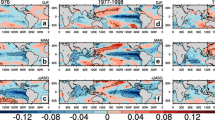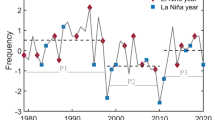Abstract
Tropical cyclone (TC) activity in the western North Pacific (WNP) has changed interdecadally with an approximately 20-year period between 1951 and 1999. The cause and mechanism of interdecadal variability of TC frequency in the WNP is investigated using NCEP/NCAR reanalysis and the result obtained from a high-resolution coupled general circulation model (CGCM). The interdecadal variability of TC activity in the WNP correlates with long-term variations in sea surface temperatures (SSTs) in the tropical central Pacific and with those of westerly wind anomalies associated with the monsoon trough that appears over the tropical WNP during the typhoon season of July to October. The westerly wind anomalies at near 10°N show positive feedback with the SST anomalies in the central Pacific. Therefore, the interdecadal variability of TC frequency is related to long-term variations in atmosphere–ocean coupling phenomena in the tropical North Pacific. A 50-year long-run simulation using the high-resolution CGCM showed the robustness of interdecadal variability of TC frequency.












Similar content being viewed by others
References
Arakawa A, Shubert WH (1974) Interaction of a cumulus cloud ensemble with the long-scale environment, Part I. J Atmos Sci 31: 674–701
Bengtsson L, Botzet M, Esch M (1996) Will greenhouse gas-induced warming over the next 50 years lead to higher frequency and greater intensity of hurricanes? Tellus 48A: 57–73
Broccoli AJ, Manabe S (1990) Can existing climate models be used to study anthropogenic changes in tropical cyclone climate? Geophys Res Lett 17: 1917–1920
Chan JCL, Shi J (1996) Long-term trends and interannual variability in tropical cyclone activity over the western North Pacific. Geophys Res Lett 23: 2765–2767
Chu PS (2002) Larege-scale circulation features associated with decadal variations of tropical cyclone activity over the central North Pacific. J Clim 15: 2678–2689
Chu PS, Clark JD (1999) Decadal variations of tropical cyclone activity over the central North Pacific. Bull Am Meteorol Soc 80: 1875–1881
Clark JD, Chu PS (2002) Interannual variation of tropical cyclone activity over the Central North Pacific. J Meteorol Soc Japan 80: 403–418
Dukowicz JK, Smith RD (1994) Implicit free-surface method for the Bryan-Cox-Semtner ocean model. J Geophys Res 99: 7991–8014
Elsner JB, Jagger T, Niu XF (2000) Changes in the rates of North Atlantic major hurricane activity during the 20th century. Geophys Res Lett 27: 1743–1746
Goldenberg SB, Landsea CB, Mestas-Nunez AM, Gray WM (2001) The recent increase in Atlantic hurricane activity: causes and implications. Science 293: 474–479
Gray WM (1968) Global view of the origin of tropical disturbances and storms. Mon Weather Rev 96: 669–700
Gray WM (1979) Hurricanes: their formation, structure and likely role in the tropical circulation. In: Shaw DB (ed) Meteorology over the tropical oceans. Royal Meteorol Society, pp 155–218
Iwasaki T, Yamada S, Tada K (1989) A parametrization scheme at orographic gravity wave drag with the different vertical partitionings. Part I: impact on medium range forecasts. J Meteorol Soc Japan 67: 11–27
JMA (1993) Appendix to progress report on numerical weather prediction. JMA: 128
Kalnay E, Kanamitu M, Kistler R, Collins W, Woollen DJ, Zhu M, Chelliah M, Ebisuzaki W, Higgins W, Janowiak J, Mo KC, Ropelewski C, Wang J, Leetmaa A, Reynolds R, Jenne R, Joseph D (1996) The NCEP/NCAR 40-year reanalysis project. Bull Am Meteorol Soc 77: 437–471
Kar SC, Sugi M, Sato N (1996) Simulation of Indian summer monsoon and its variability using JMA global model. Meteorol Res Inst Pap 47: 65–101
Katayama A (1972) A simplified scheme for computing radiative transfer in the troposphere. Tech Rep 6 UCLA
Kleeman R, McCreary JP, Klinger BA (1999) A mechanism for generating ENSO decadal variability. Geophys Res Lett 26: 1743–1746
Knutson TR, Manabe S (1998) Model assessment of decadal variability and trends in the Tropical Pacific Ocean. J Clim 11: 2273–2296
Kuo HL (1974) Further studies of the influence of cumulus convection on large scale flow. J Atmos Sci 31: 1232–1240
Latif M (1998) Dynamics of interdecadal variability in coupled ocean–atmosphere models. J Clim 11: 602–624
Lacis AA, Hansen JE (1974) A parametrization for the abosrption of solar radiation in the earth's atmosphere. J Atmos Sci 31: 118–133
Levitus S (1982) Climatological atlas of the world ocean. NOAA Prof Pap 13: 178 pp, US Government Printing Office Washington DC, USA
Lighthill J, Holland G, Gray W, Landsea C, Graig G, Evans J, Kurihara Y, Guard G (1994) Global climate change and tropical cyclones. Bull Am Meteorol Soc 75: 2147–2157
Louis J, Tiedtke M, Geleyn JF (1982) A short history of PBL parametrization at ECMWF. Workshop on planetary boundary layer parametrization, ECMWF: 59–80
Matsuura T, Yumoto M, Iizuka S, Kawamura R (1999) Typhoon and ENSO simulation using a high-resolution coupled GCM. Geophys Res Lett 26: 1755–1758
Marotzke J (1991) Influence of convective adjustment on the stability of the thermocline circulation. J Phys Oceanogr 21: 903–907
Mechoso CR, Robertson AW, Barth N, Davey MK, Deleculuse P, Gent PR, Ineson S, Kirtman B, Latif M, LeTreut H, Nagai T, Neelin JD, Philander SGH, Polcher J, Schopf PS, Stochdale T, Suarez MJ, Terray L, Thual O, Tribbia JJ (1995) The seasonal cycle over the tropical Pacific in general circulation models. Mon Weather Rev 123: 2825–2838
Mellor GL, Yamada T (1974) A hierarchy of turbulence closure models for planetary boundary layers. J Atmos Sci 31: 1791–1806
Pacanowski RC (1996) Documentation user's guide and reference manual (MOM2). GFDL Ocean Tech Rep 3.2: 329
Pacanowski RC, Philander SGH (1981) Parameterization of vertical mixing in numerical models
Paulson EA, Simpson JJ (1977) Irradiance measurements in the upper ocean. J Phys Oceanogr 8: 1572–1583
Ramage CS (1974) Monsoonal influences on the annual variation of tropical cyclone development over the Indian and Pacific Oceans. Mon Weather Rev 102: 745–753
Raper SC (1993) Climate and sea level change: observations, projections and implications. In: Warick RA, Barrow EM, Wigley TML (eds) Cambridge University Press, Cambridge, UK, pp 192–212
Regional Specialized Meteorological Center Tokyo-Typhoon Center (1992) Tropical cyclone tracks in the western North Pacific 1951–1990. Japan Meteorol Agency: 192
Reynolds RW, Smith TM (1995) A high resolution global sea surface temperature climatology. J Clim 7: 929–948
Ritchie A, Holland GJ (1999) Large-scale patterns associated with tropical cyclogenesis in the western Pacific. Mon Weather Rev 127: 2027–2043
Saito K, Baba A (1988) A statistical relation between relative humidity and the GMS observed cloud amount. J Meteorol Soc Japan 66: 187–192
Sato N, Sellers PJ, Randall DA, Schneider EK, Shukla J, Kinter JL, Hou YT, Albertazzi E (1989) Effects of inplementing the simple biosphere model in a general circulation model. J Atmos Sci 46: 2757–2782
Sellers PJ, Mintz Y, Sud YC, Dalcher A (1986) A simple biosphere model (SiB) for use within general circulation moels. J Atmos Sci 43: 505–531
Sugi M, Kuma K, Tada K, Tamiya K, Hasegawa N, Iwasaki T, Yamada S, Kitade T (1990) Description and performance of the JMA operational global spectral model (JMA-GSM88). Geophys Mag 43: 105–130
Sugi M, Kawamura R, Sato N (1995a) The climate simulated by the JMA global model. Part I: global feature. Report of National Research institute 54: 155–180
Sugi M, Nair RD, Sato N (1995b) The climate simulated by the JMA global model. Part II: tropical precipitation. Report of National Research institute 54: 181–197
Sugi M, Noda A, Sato N (2002) Influence of global warming on tropical cyclone climatology–an experiment with the JMA global model. J Meteorol Soc Japan 80: 249–272
Tiedtke M (1985) The sensitivity of the time-mean large scale flow to cumulus convection in ECMWF model. Workshop on convection in large scale numerical models. ECMWF: 297–316
Tukey JW (1977) Exploratory data analysis. Addison-Wesley Reading, Massachusetts, pp 688
Xie P, Arkin PA (1996) Analyses of global monthly precipitation using gauge observations, satellite estimates and numerical model predictions. J Clim 9: 840–858
Xie SP (1996) Westward propagation of latitudinal asymmetry in a coupled ocean–atmosphere model. J Atmos Sci 53: 3236–3250
Xie SP, Philander SGH (1994) A coupled ocean–atmosphere model of relevance to the ITCZ in the eastern. Tellus 46A: 340–350
Yukimoto S, Endo M, Kitamura Y, Kitoh A, Motoi T, Noda A (2000) ENSO-like interdecadal variability in the Pacific Ocean as simulated in a coupled general circulation model. J Geophys Res 105: 13,945–13,963
Yumoto M, Matsuura T (2001) Interdecadal variability of tropical cyclone activity in the western North Pacific. J Meteorol Soc Japan 79: 23–35
Acknowledgements.
The authors would like to thank Dr. R. Kawamura, Dr. P-S. Chu, and an anonymous reviewer for helpful suggestions. This research was conducted as a part of the project study "Study on extreme weather events and water-related disasters due to climate change" in the National Research Institute for Earth Science and Disaster Prevention of Japan. We are greatful to the Japan Meteorological Agency and Geophysical Fluid Dynamics Laboratory/NOAA for providing the code of GCMs used in the present study.
Author information
Authors and Affiliations
Corresponding author
Rights and permissions
About this article
Cite this article
Matsuura, T., Yumoto, M. & Iizuka, S. A mechanism of interdecadal variability of tropical cyclone activity over the western North Pacific. Climate Dynamics 21, 105–117 (2003). https://doi.org/10.1007/s00382-003-0327-3
Received:
Accepted:
Published:
Issue Date:
DOI: https://doi.org/10.1007/s00382-003-0327-3




